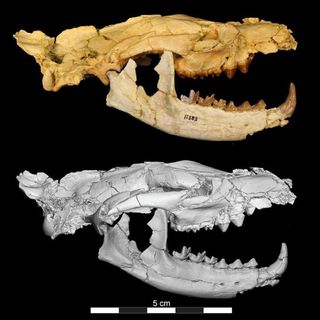Extinct Toothy Carnivore Named After Egyptian God of the Underworld

Scientists have identified a new species of small, toothy mammal that once ruled the food chain in Africa almost 40 million years ago.
Researchers named the new species Masrasector nananubis, after the ancient Egyptian god Anubis, who had the head of a jackal and was associated with mummification and the underworld. Like its namesake, M. nananubis had a long and narrow skull and lots of large teeth, the researchers wrote in a new study.
The ancient carnivore also had fox-like limbs that allowed it to move fast and hunt other small- or medium-size mammals that scrambled on the ground, the scientists said. [Image Gallery: 25 Amazing Ancient Beasts]
By studying specimens of skulls, jaws and limb bones that were unearthed outside Cairo nearly 30 years ago, the scientists were able to examine what the fearsome mammal ate, how it pursued prey and how early carnivores in Africa were related to one another.
They determined that the Masrasector nananubis was part of an extinct group of carnivorous mammals called hyaenodonts.
Despite the similar name, hyaenodonts are only distant cousins of modern-day hyenas, the researchers told Seeker. They were a group of carnivores that diverged in evolution long before the origin of cats, dogs, hyenas and honey badgers.
"Hyaenodonts were the top predators in Africa after the extinction of the dinosaurs," study author Matthew Borths, a paleontologist at Ohio University, said in a statement.
Sign up for the Live Science daily newsletter now
Get the world’s most fascinating discoveries delivered straight to your inbox.
Until now, fossil records of hyaenodonts have been sparse, Borths told PLOS Blogs. However, scientists have found evidence of the animals throughout North America, Europe, Asia and Africa, ranging from around 10 million to 60 million years ago.
"This new species is associated with a dozen specimens, including skulls and arm bones," he said.
This means the M. nananubis fossils can now be used for comparisons with other hyaenodonts, to help scientists better understand the animals' evolution and their role in each ecosystem. "We can explore what it ate, how it moved, and consider why these carnivorous mammals died off as the relatives of dogs, cats and hyenas moved into Africa," Borths said.
The research was published online April 19 in the open-access journal PLOS ONE.
Original article on Live Science.
Most Popular


